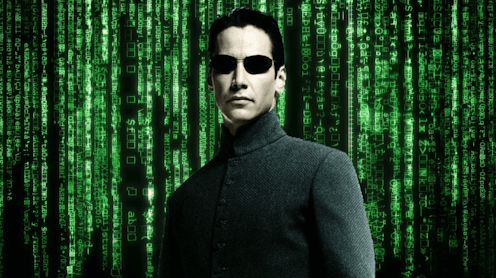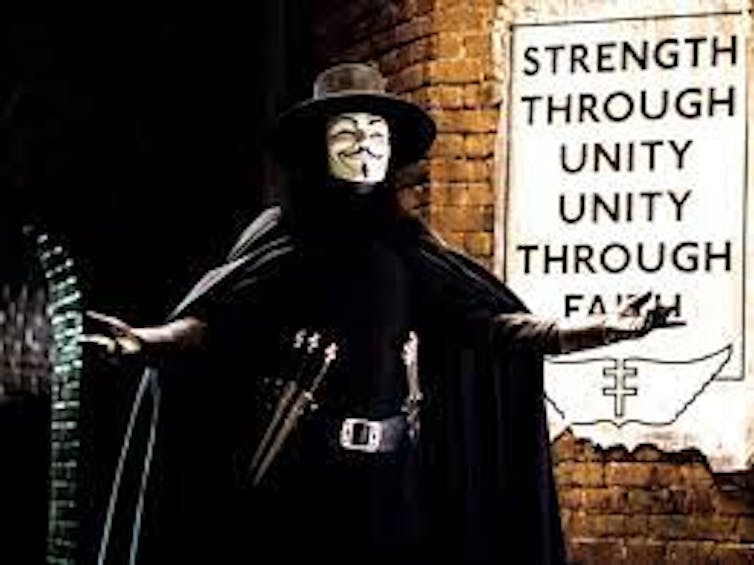Source: The Conversation (Au and NZ) – By Naja Later, Academic Tutor in Media and Communications, Swinburne University of Technology

With Lana Wachowski’s The Matrix Resurrections about to hit theatres, we’re going to see a lot of criticism interpreting siblings Lana and Lilly Wachowskis’ body of films through a trans lens. I’m really looking forward to it: it’s a great opportunity for trans critics, and there are so few Hollywood movies – or pop culture in general – with openly trans creators for us to talk about.
Lilly Wachowski, quoted in the excellent Cael M. Keegan text The Wachowskis: Sensing Transgender, once said: “There’s a critical eye being cast back on Lana’s and my work through the lens of our transness, and this is a cool thing, because it’s an excellent reminder that art is never static.”
The Matrix, being the Wachowskis’ most popular film, is ripe for a trans reading. Vulture critic Andrea Long Chu summarises it as: “Neo has dysphoria. The Matrix is the gender binary. The agents are transphobia. You get it.”
I would also caution the risk of the Wachowskis’ art becoming “static” as trans art. Identity politics, celebrity culture and the ritualisation of “coming out” all influence our understanding of the Wachowskis and their work.
It would be easy to interpret the Wachowskis’ canon as innately trans, but in doing so, we might be relying too heavily on auteur theory in film.

Murray Close/ Warner Bros. Entertainment Inc
The director is king
Auteur theory was originally coined by filmmaker-critic François Truffaut in 1954: he championed original films by directors with unique stylistic signatures. The theory has been contentious but popular in the English-speaking world since Andrew Sarris adapted the idea for Hollywood in the 1960s, proposing (if tongue-in-cheek) the idea that “the director is king.”
Auteur theory mythologises the director as the singular visionary behind a film. While recognising filmmakers’ signatures can be rewarding, a solid film shouldn’t be contingent on it.
Auteur theory overemphasises a storyteller’s personal life in their public work. When we talk about authentic representation in pop culture, and the historic under-representation of marginalised storytellers, it’s tempting to conflate them as one issue.
Read more:
The Matrix 20 years on: how a sci-fi film tackled big philosophical questions
Trans people and trans stories
On a surface level, it makes sense trans people should tell trans stories, but this quickly becomes an argument that only trans people can tell only trans stories. This is especially troubling with trans identities. Not every trans person comes out before they start sharing their work.
It’s overwhelmingly likely that in Hollywood’s history, plenty of filmmakers were trans: we just didn’t know it. This logic deeply affected the Wachowskis’ first feature, 1996’s Bound: Keegan notes that the film was overlooked as iconic lesbian cinema at the time. The Wachowskis’ success in Hollywood cannot be extricated from their staying in the closet: Lana came out in 2010, between directing her sixth film (Speed Racer) and the seventh (Cloud Atlas). Lilly came out in 2016, after threats from the Daily Mail to out her regardless.
We have to ask: if the Wachowskis had never come out (especially in Lilly’s case, since she was outed against her will) would these films still feel trans? Would their narratives still resonate with the many fans who’ve come out as trans since seeing The Matrix? I think so: it’s not a coincidence so many trans fans identify with narratives about discovering your true self and fighting to free others from the constrictions of normative life.
Could a wildly ambitious and delightfully girlish box-office bomb like Jupiter Ascending have been made without the unique career trajectory of the Wachowskis? Yes, it’s rewarding to retroactively analyse their work as trans – Keegan identifies revisitation as a part of trans meaning-making – but it would be disappointing to stop at two directors’ finite catalogue of films.

IMDB
This is an opportunity to look at the limits of auteur theory, and how much we should rely on directors’ personal lives to shape the way we interpret media.
Auteur theory risks omitting interesting narratives about gender from directors – and other filmmakers – who aren’t out of the closet, or who simply tell insightful stories without having the personal experience of being trans. We need not uncover a trans crew member behind Guillermo del Toro’s movies to find his metaphors of love and monstrosity resonate powerfully with our own trans experiences – we might just as well watch Alien or Hackers and say “oh, that’s gender.”
At the endpoint of this argument that “only trans creators can tell trans stories” is a very dangerous myth that trans people are innately deceptive if we stay in the closet for safety, privacy, or simply as a preference. We must be allowed to assume anyone can tell an interesting story about gender, whether they’re cis or trans; a director or the key grip.
Looking beyond gender
If we can embrace the idea trans narratives can be made by anyone, we should also embrace the idea trans creators can make narratives about anything. The obsession with what we know about the Wachowskis’ personal lives can overshadow other analyses.
There are troubling racial and colonial themes at work in films like Cloud Atlas that are overlooked through a (white) trans framework, and a fascinating British/Anglican context to V for Vendetta that vanishes with original writer Alan Moore’s disavowal of all film adaptations of his comics. While trans analysis is interesting, and there’s plenty to say, it can mean overlooking other narratives and problems in the Wachowskis’ work.

IMDB
The transness in the Wachowskis’ work isn’t nearly so simple as “the red pill is oestrogen.” If we can look past the fad of films-as-ciphers, there’s bigger ways of thinking about gender that don’t require a PhD in Baudrillard.
The Matrix proposes that your self-image is separate from your physical body; that everyone raised in an oppressive system will violently defend that system unless they’re ready to rip themselves free of it; that we all fall on our first jump, but with love and belief from others we can become ourselves; that our duty is to free others after that and to break the entire system so it cannot be rebuilt.
Yes, gender is one of those systems, but films like Cloud Atlas and Jupiter Ascending are more concerned with the exploitation of proletariat bodies to feed a surface of luxury: these themes have more to say about capitalism than a reading that treats gender subtext like crossword clues.
Encrypted autobiographies
The Wachowskis have always strongly branded their films and supplementary material: this, and their distinctive signature themes, make them a great choice for auteur theory.
In highlighting invisible labour in the text, we’re invited to consider the kind of labour that went into making the text. Over-dependence on auteur theory can obscure the creative teamwork it takes to make a film.
Treating their works as encrypted autobiographies risks ignoring the kind of paradigms they seek to destroy, and the potential for all storytellers to challenge systems they’re not publicly oppressed by.
I am sure there will be many fascinating, nuanced, trans-led analyses of The Matrix Resurrections. What I’m hoping for is analysis of The Matrix Resurrections as more than a Wachowski film, as more than a trans film, and for more trans analysis of all films.
![]()
Naja Later does not work for, consult, own shares in or receive funding from any company or organisation that would benefit from this article, and has disclosed no relevant affiliations beyond their academic appointment.
– ref. Is The Matrix a trans film? Revisiting the Wachowskis through a trans lens – https://theconversation.com/is-the-matrix-a-trans-film-revisiting-the-wachowskis-through-a-trans-lens-170960








